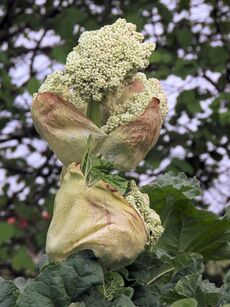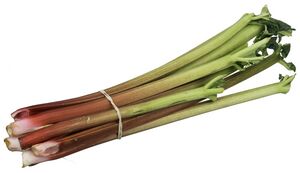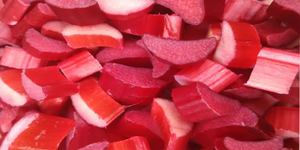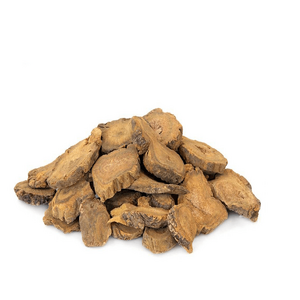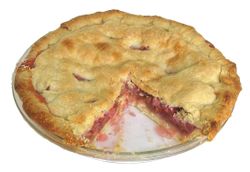راوند
| الراوند Rhubarb | |
|---|---|
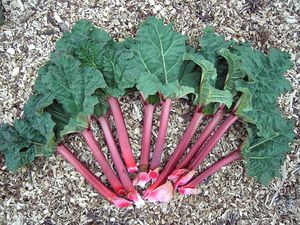
| |
| التصنيف العلمي | |
| مملكة: | |
| (unranked): | |
| (unranked): | |
| (unranked): | |
| Order: | |
| Family: | |
| Genus: | |
| Species: | R. rhabarbarum
|
| Binomial name | |
| Rheum rhabarbarum | |
الراوند Rhubarb هو مجموعة من النباتات التي تنتمي إلى جنس Rheum في الفصيلة البطباطية Polygonaceae.[1] النبات عبارة عن نبات عشبي معمر ينمو من جذور قصيرة وسميكة. تاريخيًا، أُطلق على النباتات المختلفة اسم "الراوند" باللغة الإنجليزية.
تحتوي الأوراق الكبيرة المثلثة على مستويات عالية من حمض الأوكساليك وجليكوسيدات الأنثرون، مما يجعلها غير صالحة للأكل. يتم تجميع الزهور الصغيرة في النورات المركبة الكبيرة الورقية ذات اللون أبيض إلى لون أحمر وردي.
الأصل الدقيق لراوند الطهي غير معروف. الأنواع Rheum rhabarbarum (syn. R. undulatum) و R. rhaponticum تمت زراعتها في أوروبا قبل القرن الثامن عشر وتستخدم للأغراض الطبية. بحلول أوائل القرن الثامن عشر، تمت زراعة هذين النوعين وهجين محتمل من أصل غير معروف، R. × hybridum، كمحاصيل نباتية في إنجلترا والدول الاسكندنافية. يتم تهجينها بسهولة، وتم تطوير راوند الطهي عن طريق اختيار بذور مفتوحة التلقيح، لذلك يكاد يكون من المستحيل تحديد أصله الدقيق.[2]
في المظهر، تختلف عينات راوند الطهي على التوالي بين R. rhaponticum و R. rhabarbarum. ومع ذلك، فإن أصناف الراوند الحديثة هي tetraploids with 2n = 44, in contrast to 2n = 22 للأنواع البرية.[3]
على الرغم من أن الراوند من الخضروات، إلا أنه غالبًا ما يستخدم لنفس استخدامات الطهي مثل الفواكه.[4] يمكن استخدام سيقان الأوراق نيئة، عندما يكون قوامها مقرمشًا (يشبه الكرفس، على الرغم من أنه ينتمي إلى عائلة مختلفة)، ولكن يتم طهيها بشكل شائع مع السكر واستخدامها في الفطائر، والفتات وغيرها من الحلويات. لديهم طعم لاذع قوي. تم تطوير العديد من الأصناف للاستهلاك البشري، وتم التعرف على معظمها على أنها Rheum × hybridum من قبل الجمعية البستانية الملكية.[5]
الوصف النباتي
الراوند نبات معمر، وتوجد منه عدة أنواع أهمها: راوند الراحى، والراوند الهندي، والراوند الصيني. أوراقه راحية كبيرة الحجم وحافتها مسننة أو متماوجة، وعنق الورقة شحمي، الأزهار وحيدة الجنس في سنابل كثيفة لونها أبيض مشرب بالأخضر.
الزراعة
يُزرع نبات الراوند على نطاق واسع، ويُنتج من خلال الدفيئة فهو متاح طوال معظم أيام العام. تحتاج إلى هطول الأمطار وفترة باردة سنوية تصل إلى 7-9 أسابيع عند درجة حرارة 3 درجات مئوية (37 درجة فهرنهايت)، والمعروفة باسم "الوحدات الباردة"، لتنمو بشكل جيد. يقوم النبات بتطوير عضو تخزين كبير تحت الأرض (تيجان الراوند) ويمكن استخدامه للإنتاج المبكر عن طريق نقل التيجان المزروعة في الحقل إلى الظروف الدافئة.[6] يُطلق على نبات الراوند المزروع في الدفيئات الزراعية (الدفيئات المدفأة) اسم "الراوند الدفيئ"، ويتم توفيره عادةً في الأسواق الاستهلاكية في أوائل الربيع، قبل توفر نبات الراوند المزروع في الهواء الطلق. عادةً ما يكون راوند الدفيئة أكثر إشراقًا باللون الأحمر وأكثر طراوة وأحلى مذاقًا من الراوند الخارجي.[7] بعد إجبارها على الإنتاج التجاري، عادة ما يتم التخلص من التيجان.[6] في المناخ المعتدل، يعد نبات الراوند واحدًا من أوائل النباتات الغذائية التي يتم حصادها، وعادةً ما يكون ذلك في منتصف إلى أواخر الربيع (أبريل أو مايو في نصف الكرة الشمالي، أو أكتوبر أو نوفمبر في نصف الكرة الجنوبي)، ويستمر موسم زراعة النباتات المزروعة في الحقل حتى نهاية الصيف.
في المملكة المتحدة، يتم حصاد أول راوند في العام على ضوء الشموع في حظائر حيث يتم استبعاد كل الأضواء الأخرى، وهي ممارسة تنتج ساقًا أكثر حلاوة وأكثر طراوة.[8] تنتشر هذه الحظائر حول "مثلث الراوند" في يوركشر بين ويكفيلد، وليدز، ومورلي.[9]
يتم إنتاج نبات الراوند في الولايات المتحدة بشكل أساسي في ولايات أوريگون، وواشنطن، وويسكنسن بمساحة إنتاج تبلغ حوالي 1200 فدان، منها 175 فدانًا مغطاة بالدفيئات الزراعية.[10] في ولايتي أوريگون وواشنطن بشمال غرب الولايات المتحدة، عادة ما يكون هناك موسمان للحصاد، من أواخر أبريل إلى مايو ومن أواخر يونيو إلى يوليو؛[11] نصف الإنتاج التجاري الأمريكي يقع في مقاطعة بيرس، واشنطن.[12] الراوند جاهز للاستهلاك بمجرد حصاده، والسيقان المقطوعة حديثًا تكون صلبة ولامعة.
لا ينبغي تناول نبات الراوند الذي تضرر بسبب البرد الشديد، لأنه قد يحتوي على نسبة عالية من حمض الأوكساليك، الذي يهاجر من الأوراق ويمكن أن يسبب المرض.[13]
يمكن أن يختلف لون سيقان الراوند من اللون الأحمر القرمزي المرتبط عادة، إلى اللون الوردي الفاتح المرقط، إلى اللون الأخضر الفاتح ببساطة. توصف سيقان الراوند بشكل شعري بأنها "سيقان قرمزية". ينتج اللون عن وجود الأنثوسيانين، ويختلف وفقًا لنوع الراوند وتقنية الإنتاج. اللون لا علاقة له بمدى ملاءمته للطهي.[14]
زراعة الراوند تاريخياً
يطلق الصينيون على الراوند اسم "الأصفر العظيم" (dà huáng 大黃)، وقد استخدموا جذر الراوند للأغراض الطبية.[15] يظهر في كتاب The Divine Farmer's Herb-Root Classic، والذي يُعتقد أنه تم تجميعه منذ حوالي 1800 عام.[16]
على الرغم من أن وصف ديوسكوريدس لـ [ρηον] Error: {{Transliteration}}: transliteration text not Latin script (pos 1: ρ) (help) أو [ρά] Error: {{Transliteration}}: transliteration text not Latin script (pos 1: ρ) (help) يشير إلى أن الجذر الطبي الذي تم جلبه إلى اليونان من خارج البوسفور ربما كان راوند، إلا أن التجارة في النبات لم تصبح راسخة بشكل آمن حتى العصور الإسلامية. وفي العصر الإسلامي، تم استيراده على طول طريق الحرير، ووصل إلى أوروبا في القرن الرابع عشر عبر موانئ حلب وسميرنا، حيث أصبح يُعرف باسم "الراوند التركي".[17]
لاحقًا،[when?] بدأت في الوصول عبر طرق بحرية جديدة وبرًا عبر روسيا. كان "الراوند الروسي" هو الأكثر قيمة، ربما بسبب نظام مراقبة الجودة الخاص بالراوند الذي كانت تطبقه الإمبراطورية الروسية.[18]
تكلفة النقل عبر آسيا جعلت الراوند باهظ الثمن في أوروبا في العصور الوسطى. وكان سعره أضعاف ثمن الأعشاب والتوابل الثمينة الأخرى مثل القرفة، والأفيون، والزعفران. ولذلك بحث التاجر المستكشف ماركو بولو عن المكان الذي يزرع فيه النبات ويحصد، فاكتشف أنه يزرع في جبال مقاطعة تانغوت.[16]
يمكن رؤية قيمة الراوند في تقرير Ruy Gonzáles de Clavijo عن سفارته في 1403-1405 إلى تيمور في سمرقند: "كان أفضل البضائع القادمة إلى سمرقند من الصين: وخاصة الحرير، والساتان، والمسك، والياقوت، والألماس، واللؤلؤ، والراوند...."[19]
وقد حفز السعر المرتفع، فضلاً عن الطلب المتزايد من الصيدليات، الجهود المبذولة لزراعة الأنواع المختلفة من الراوند في الأراضي الأوروبية.[18] تم زراعة أنواع معينة في إنجلترا لإنتاج الجذور.[20]
أدى التوافر المحلي للنباتات المزروعة للأغراض الطبية، إلى جانب الوفرة المتزايدة وانخفاض أسعار السكر في القرن الثامن عشر، إلى تحفيز اعتمادها في الطهي.[18] يدعي غريف أن تاريخه هو عام 1820 في إنجلترا.[20] تم حصاد نبات الراوند في اسكتلندا منذ عام 1786 على الأقل، بعد أن تم تقديمه إلى الحديقة النباتية في إدنبرة بواسطة الرحالة بروس كينيرد في عام 1774. وقد أحضر البذور من الحبشة وأنتجوا 3000 نبات.[21]
على الرغم من أنه من المؤكد غالبًا أن نبات الراوند وصل إلى الولايات المتحدة لأول مرة في عشرينيات القرن التاسع عشر،[22] إلا أن جون بارترام كان يزرع نباتات الراوند الطبي والطهوي في فيلادلفيا منذ ثلاثينيات القرن الثامن عشر، حيث كان يزرع البذور التي أرسلها إليه بيتر كولينسون.[23]
منذ البداية، لم يكن نبات الراوند المألوف في الحديقة هو نبات "الراوند" الوحيد في الحدائق الأمريكية: فقد زرع توماس جيفرسون نبات R. undulatum في مونتايسلو في عامي 1809 و1811، مع ملاحظة أن نبات الراوند كانت أوراقه ممتازة مثل السبانخ."[24]
الزريعات
قام مؤيد البستنة العضوية لورانس دي هيلز بإدراج أصناف الراوند المفضلة لديه من حيث النكهة مثل 'Hawke's Champagne' و'Victoria' و'Timperley Early' و'Early Albert'، كما أوصى أيضًا بـ 'Gaskin's Perpetual' لاحتوائه أدنى مستوى من حمض الأكساليك، مما يسمح بحصاده على مدى فترة أطول بكثير من موسم النمو دون الإصابة بالحموضة المفرطة.[25]
تمتلك الجمعية البستانية الملكية المجموعة الوطنية لنبات الراوند في المملكة المتحدة والتي تضم 103 صنف. في 2021-2022، تم نقل هذا من جنوب إنجلترا إلى الحديقة الشمالية RHS Bridgewater حيث يكون برد الشتاء وهطول الأمطار أكثر ملاءمة للراوند.[26] حصلت الأصناف التالية على جائزة تقدير الحدائق من الجمعية البستانية الملكية:[27]
الاستخدامات
| القيمة الغذائية لكل 100 g (3.5 oz) | |
|---|---|
| الطاقة | 88 kJ (21 kcal) |
4.54 g | |
| Sugars | 1.1 g |
| ألياف غذائية | 1.8 g |
0.3 g | |
0.8 g | |
| الڤيتامينات | |
| ثيامين (B1) | (2%) 0.02 mg |
| ريبوفلاڤين (B2) | (3%) 0.03 mg |
| نياسين (B3) | (2%) 0.3 mg |
(2%) 0.085 mg | |
| ڤيتامين B6 | (2%) 0.024 mg |
| فولات (B9) | (2%) 7 μg |
| Choline | (1%) 6.1 mg |
| Vitamin C | (10%) 8 mg |
| ڤيتامين E | (2%) 0.27 mg |
| ڤيتامين ك | (28%) 29.3 μg |
| آثار فلزات | |
| كالسيوم | (9%) 86 mg |
| حديد | (2%) 0.22 mg |
| الماغنسيوم | (3%) 12 mg |
| المنگنيز | (9%) 0.196 mg |
| فوسفور | (2%) 14 mg |
| پوتاسيوم | (6%) 288 mg |
| صوديوم | (0%) 4 mg |
| زنك | (1%) 0.1 mg |
| مكونات أخرى | |
| ماء | 94 g |
| |
| Percentages are roughly approximated using US recommendations for adults. Source: USDA Nutrient Database | |
يُزرع نبات الراوند في المقام الأول من أجل سيقان أوراقه اللحمية، المعروفة تقنيًا باسم أعناق. يعد استخدام سيقان الراوند كغذاء ابتكارًا حديثًا نسبيًا. تم تسجيل هذا الاستخدام لأول مرة في إنجلترا في القرن الثامن عشر إلى القرن التاسع عشر بعد أن أصبح السكر متاحًا على نطاق أوسع بأسعار معقولة.[18][20]
عادة، يتم طهيه مع السكر أو استخدامه في الفطائر والحلويات، ولكن يمكن أيضًا وضعه في أطباق مالحة أو مخلل. يمكن تجفيف الراوند وغمره بعصير الفاكهة. في الولايات المتحدة، عادة ما يتم نقعها مع عصير الفراولة لتقليد فطيرة راوند الفراولة الشهيرة.
الغذاء
تم تناول أنواع Rheum ribes في العالم الإسلامي منذ القرن العاشر.[32]
في شمال أوروبا وأمريكا الشمالية، عادة ما يتم تقطيع السيقان إلى قطع وطهيها مع السكر المضاف حتى تصبح طرية.[33] يمكن بعد ذلك استخدام الكومبوت الناتج، والذي يتم تكثيفه أحيانًا بنشا الذرة، في الفطائر. وبدلاً من ذلك، يمكن إضافة كميات أكبر من السكر مع البكتين لصنع المربى. التوابل المقترنة المستخدمة هي الزنجبيل، على الرغم من أن القرفة و جوزة الطيب من الإضافات الشائعة أيضًا.
في المملكة المتحدة، بالإضافة إلى استخدامه في الفطائر النموذجية والفطائر والمفتتات، يتم دمج كومبوت الراوند أيضًا مع الكريمة المخفوقة أو الكسترد لصنع كذبة الراوند. في الولايات المتحدة، أدى الاستخدام الشائع للراوند في الفطائر إلى تسميته بـ "نبات الفطائر"، والذي تمت الإشارة إليه في كتب الطبخ في القرن التاسع عشر.[34] غالبًا ما يتم أيضًا إقران نبات الراوند في الولايات المتحدة بالفراولة لصنع فطيرة الراوند والفراولة، على الرغم من أن بعض أنصار الراوند يعتبرون مازحين أن هذا "زواج غير سعيد إلى حد ما".[34]
يمكن أيضًا استخدام الراوند لصنع المشروبات الكحولية، مثل نبيذ الفاكهة أو الراوند الفنلندي سيما (ميد). كما أنها تستخدم لصنع كومبوت.[35]
التغذية
الراوند الخام يتكون من 94% ماء، و5% كربوهيدرات، و1% بروتين، ويحتوي على نسبة ضئيلة من الدهون. في كمية مرجعية تبلغ 100 جرام، يوفر الراوند الخام 88 كيلوجول (21 كيلو كالوري) من الطاقة الغذائية، وهو مصدر غني لـ فيتامين ك (28% من القيمة اليومية، DV)، ومصدر معتدل لـ فيتامين C (10% DV)، ولا يحتوي على أي مغذيات دقيقة أخرى بكميات كبيرة.
الطب الصيني التقليدي
في الطب الصيني التقليدي، تم استخدام جذور الراوند لعدة أنواع كملين لعدة آلاف السنين،[36] على الرغم من عدم وجود أدلة سريرية تشير إلى فعالية هذا الاستخدام.[37]
المواد الفعالة
تحتوي المادة الفعالة في الراوند على حوالي 10 % من الكينونات وهي أهم ما فيه، بالإضافة إلى مواد دابغة أخرى. المستعمل منه ريزومات الجذر للنبات المعمر لعامين أو ثلاثة، وهي تحتوي على مادة ذات رائحة متميزة وطعم مر. درنات الراوند هو أحد الخضراوات التي تنمو على تنمو على نباتات دائمة الخضرة. ومصدره الأصلي منغوليا. ولكنه ينمو في الأقاليم المعتدلة في أوروبا وأمريكا. ويشكل جذراً تخزينياً أصفر كبيراً، ومجموعة من الجذور التي تمده بالغذاء تحت الأرض. وينتج جذره الموجود براعم، تنمو منها سيقان ورقية بها أوراق كبيرة. ويستخدم الناس السيقان ذات العصير المائل كغذاء. وتحتوي الأوراق على أملاح حمضية سامة من الأوكسالات. وعادة ما يطهو الناس الراوند كحلوى. وكثيراً ما يستخدم حشواً للفطائر وأيضاً كنوع من الصلصة.
ويحتوي الراوند على نسبة محدودة من فيتامين"ج" وله خواص تليينية. ويوجد به مادة بالإنجليزية: anthraquinones في الصيف المسهلة وتانين قابض ويوقف الإسهال، وبه مادة anthranoles في الصيف. والمسحوق طعمه مر ولو أخذ بكميات قليلة يفتح الشهية. ويستعمل لعلاج الإمساك والدوسنتاريا والديدان الدبوسية وقرحة الإثني عشر. وينشط نزول دم الحيض. ويستعمل كدهان لمنع نزيف البواسير. وكمضمضة لعلاج قرح الفم.
راوند (Rhubarb) أو درنات الراوند بها مادة anthraquinones المسهلة وتانين قابض ويوقف الإسهال ،. والمسحوق طعمه مر ولو أخذ بكميات قليلة يفتح الشهية .ويستعمل لعلاج الإمساك والدوسنتاريا والديدان الدبوسية وقرحة الإثني عشر. وينشط نزول دم الحيض. ويستعمل كدهان لمنع نزيف البواسير. و كمضمضة لعلاج قرح الفم .
الخصائص الطبية
- يستعمل مغلي أو صبغة جذر الراوند كمقو للمعدة.
- يستخدم المسحوق المستخلص منه لفتح الشهية وعلاج الإمساك المزمن واضطرابات والتهابات المعدة.
- الجرعات الخفيفة من الصبغة (5 ـ 10) نقاط قابضة وتستعمل للإسهال، والجرعات المركزة (1 مل) تستعمل كمنبه ومنشط لعمل الكبد.
- ينصح المصابون بحصى الكلى بعدم استعمال الراوند بكثرة.
- يحظر استعمال الأوراق فمن المحتمل أن تكون سامة.
- ينصح بتجنب العشبة أثناء الحمل لأنها مسهل قوي.
الآفات
الراوند هو مضيف لنبات الراوند، Lixus concavus، وهو سوسة. يظهر الضرر بشكل رئيسي على الأوراق والسيقان، with gummosis and oval or circular feeding and egg-laying sites.[38]
قد تحفر الحياة البرية الجائعة جذور الراوند وتأكلها في الربيع، حيث يتم تحويل النشويات المخزنة إلى سكريات لنمو أوراق الشجر الجديدة.
كتاب الطبخ
 Rhubarb Cake at Wikibook Cookbooks
Rhubarb Cake at Wikibook Cookbooks Rhubarb Crumble at Wikibook Cookbooks
Rhubarb Crumble at Wikibook Cookbooks Rhubarb Fool at Wikibook Cookbooks
Rhubarb Fool at Wikibook Cookbooks Rhubarb Juice at Wikibook Cookbooks
Rhubarb Juice at Wikibook Cookbooks Rhubarb Marmalade at Wikibook Cookbooks
Rhubarb Marmalade at Wikibook Cookbooks Rhubarb Pie at Wikibook Cookbooks
Rhubarb Pie at Wikibook Cookbooks Rhubarb Pudding at Wikibook Cookbooks
Rhubarb Pudding at Wikibook Cookbooks Strawberry Rhubarb Pie at Wikibook Cookbooks
Strawberry Rhubarb Pie at Wikibook Cookbooks
معرض الصور
A 19th-century apothecary jar for rhubarb
مرئيات
| فوائد عشبة الراوند. |
| ما هي فوائد عشبة الراوند؟ |
| عشبة الراوند، تعرف على شكلها وموطنها الذي تنبت فيه وبعض من فوائدها الكبيرة. |
الهامش
- ^ Foust, Clifford M.; Marshall, Dale E. (1 November 1991). "Culinary Rhubarb Production in North America: History and Recent Statistics". HortScience. 26 (11): 1360–1363. doi:10.21273/hortsci.26.11.1360. ISSN 0018-5345.
- ^ Tanhuanpää, Pirjo; Suojala-Ahlfors, Terhi & Hartikainen, Merja (2019). "Genetic diversity of Finnish home garden rhubarbs (Rheum spp.) assessed by simple sequence repeat markers". Genetic Resources and Crop Evolution. 66 (1): 17–25. doi:10.1007/s10722-018-0692-8. S2CID 52821042.
- ^ Libert, Bo & Englund, Roger (1989). "Present Distribution and Ecology of Rheum rhaponticum (Polygonaceae)". Willdenowia. 19 (1): 91–98. JSTOR 3996925.
- ^ Hood, Karen Jean Matsko (2014-01-01). Rhubarb Delights Cookbook: A Collection of Rhubarb Recipes (in الإنجليزية). Spokane Valley: Whispering Pine Press International. pp. 20, 22. ISBN 978-1-930948-00-6.
- ^ "RHS Plantfinder – Rhubarb". Retrieved 23 September 2018.
- ^ أ ب "Rhubarb". Royal Horticultural Society. Retrieved 23 January 2022.
- ^ Rombauer, Irma S. (1975) Joy of Cooking. Indianapolis/New York: Bobbs-Merrill Co., Inc. p. 142. ISBN 978-0672518317
- ^ McGee, Harold (2004). On Food and Cooking. New York, NY: Scribner. p 367. ISBN 978-0-684-80001-1
- ^ Wakefield Metropolitan District Council. "Rhubarb". Archived from the original on 30 September 2008. Retrieved 12 March 2006.
- ^ Support, Extension Web (19 June 2018). "Rhubarb". Ag - Processed Vegetables. Oregon State University. Retrieved 18 November 2022.
- ^ Learn To Grow (31 July 2015), How To Harvest Rhubarb, https://www.youtube.com/watch?v=xU392gqTHLU, retrieved on 17 May 2017
- ^ "Pierce County Agriculture". 31 July 2009. Archived from the original on 31 July 2009. Retrieved 30 July 2018.
- ^ "Growing Rhubarb in the Home Garden". Ohio State University Extension Fact Sheet. Archived from the original on 5 June 2013. Retrieved 4 June 2013.
- ^ "Rhubarb Varieties". Rhubarbinfo.com. 1 September 2004. Retrieved 5 March 2010.
- ^ Mehta, Sweety (27 December 2012). "Pharmacognosy of Rhubarb". PharmaXChange.info.
- ^ أ ب John Uri Lloyd (1921). Origin and History of All the Pharmacopeial Vegetable Drugs, Chemicals and Origin and History of All the Pharmacopeial Vegetable Drugs, Chemicals and Preparations with Bibliography. Vol. 1. Read Books. ISBN 978-1-4086-8990-5.
- ^ Warmington, E. H. (1928). The Commerce Between the Roman Empire and India. Cambridge: Cambridge University Press. p. 207ff. ISBN 978-1-00-136124-6.
- ^ أ ب ت ث Monahan, Erika (2013). "Locating rhubarb". In Findlen, Paula (ed.). Early modern things: objects and their histories, 1500–1800. Abingdon: Routledge. pp. 227–251. ISBN 978-0-415-52051-5.
- ^ Quoted in Wood, Frances (2002). The Silk Road: Two Thousand Years in the Heart of Asia. University of California Press. p. 13. ISBN 978-0-520-24340-8.
- ^ أ ب ت Grieve, M. (1900). "Rhubarbs". botanical.com. A Modern Herbal. Retrieved 2023-02-23.
- ^ Grants Old and New Edinburgh
- ^ Waters, Alice (2002) Chez Panisse Fruit. New York: Harper Collins. p. 278. ISBN 978-0060199579
- ^ Fry, Joel (2012-07-20). David H (ed.). "Did John Bartram introduce rhubarb to North America?". Growing History (in الإنجليزية). Retrieved 2023-02-23.
- ^ "Rhubarb « Thomas Jefferson's Monticello". 2011-06-12. Archived from the original on 12 June 2011. Retrieved 2023-02-23.
- ^ Lawrence D Hills. Organic Gardening. Penguin 1997. page 145
- ^ "RHS Bridgwater". RHS Garden Bridgewater Instagram. Retrieved 23 January 2022.
- ^ "AGM Plants – Ornamental" (PDF). Royal Horticultural Society. July 2017. p. 84. Retrieved 27 September 2018.
- ^ "RHS Plantfinder – Rheum × hybridum 'Grandad's Favourite'". Retrieved 23 September 2018.
- ^ "RHS Plantfinder – Rheum × hybridum 'Reed's Early Superb'". Retrieved 23 September 2018.
- ^ "RHS Plantfinder – Rheum × hybridum 'Stein's Champagne'". Retrieved 23 September 2018.
- ^ "RHS Plantfinder – Rheum × hybridum 'Timperley Early'". Retrieved 23 September 2018.
- ^ "Andalusian Cookbook: Table of Contents". www.daviddfriedman.com. Retrieved 2023-02-23.
- ^ Lyle, Katie Letcher (2010) [2004]. The Complete Guide to Edible Wild Plants, Mushrooms, Fruits, and Nuts: How to Find, Identify, and Cook Them (2nd ed.). Guilford, CN: FalconGuides. p. 111. ISBN 978-1-59921-887-8. OCLC 560560606.
- ^ أ ب Neal, Bill (2003) [1990]. Biscuits, Spoonbread and Sweet Potato Pie. Chapel Hill, NC: University of North Carolina Press. p. 308. ISBN 978-0807854747.
- ^ "Rhubarb Compote". Epicurious (in الإنجليزية الأمريكية). 7 April 2008. Retrieved 2023-02-23.
- ^ Barceloux, Donald G (2012). Medical Toxicology of Natural Substances: Foods, Fungi, Medicinal Herbs, Plants, and Venomous Animals. John Wiley & Sons. p. 235. ISBN 978-1-118-38276-9.
- ^ خطأ استشهاد: وسم
<ref>غير صحيح؛ لا نص تم توفيره للمراجع المسماةdrugs - ^ قالب:Cite eb
- CS1 الإنجليزية الأمريكية-language sources (en-us)
- Articles containing صينية-language text
- Transliteration template errors
- Vague or ambiguous time from May 2024
- Pages with empty portal template
- Rhubarb
- نباتات طبية
- Perennial vegetables
- Plants described in 1753
- أصنوفات سماها كارل لينايوس
- Rheum (plant)
- Stem vegetables
- Nephrotoxins
- بطباطية
- خضراوات ساقية
